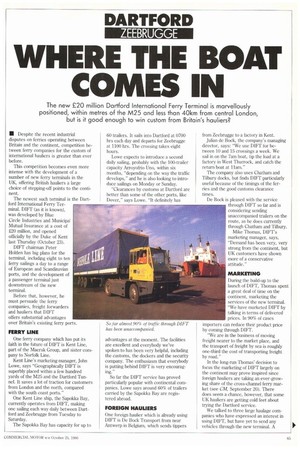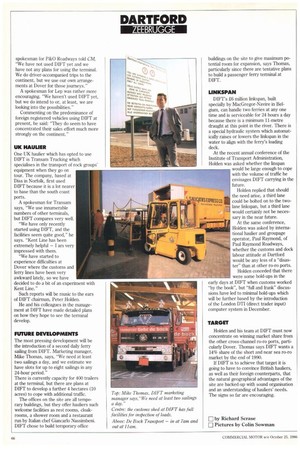WHERE THE BOAT COMES IN
Page 67

Page 68

If you've noticed an error in this article please click here to report it so we can fix it.
The new £20 million Dartford International Ferry Terminal is marvellously positioned, within metres of the M25 and less than 40km from central London, but is it good enough to win custom from Britain's hauliers?
• Despite the recent industrial disputes on ferries operating between Britain and the continent, competition between ferry companies for the custom of international hauliers is greater than ever before.
This competition becomes even more intense with the development of a number of new ferry terminals in the UK, offering British hauliers a large choice of stepping-off points to the continent.
The newest such terminal is the Dartford International Ferry Terminal_ DIFT (as it is known), was developed by Blue Circle Industries and Municipal Mutual Insurance at a cost of 220 million, and opened officially by the Duke of Kent last Thursday (October 13).
DIFT chairman Peter Holden has big plans for the terminal, including eight to ten ferry sailings a day to a range of European and Scandinavian ports, and the development of a passenger terminal just downstream of the new terminal.
Before that, however, he must persuade the ferry companies, freight forwarders and hauliers that DIFT offers substantial advantages over Britain's existing ferry ports.
FERRY LINE
One ferry company which has put its faith in the future of DIET is Kent Line, part of the Maersk Group, and sister company to Norfolk Line.
Kent Line's marketing manager, John Lowe, says "Geographically DIFT is superbly placed within a few hundred yards of the M25 and the Dartford Tunnel. It saves a lot of traction for customers from London and the north, compared with the south coast ports."
One Kent Line ship, the Sapokka Bay, currently operates from DIFT, making one sailing each way daily between Dartford and Zeebrugge from Tuesday to Saturday.
The Sapokka Bay has capacity for up to 60 trailers. It sails into Dartford at 0700 hrs each day and departs for Zeebrugge at 1100 hrs. The crossing takes eight hours.
Lowe expects to introduce a second daily sailing, probably with the 100-trailer capacity Arroyofrio Uno, within six months, "depending on the way the traffic develops," and he is also looking to introduce sailings on Monday or Sunday.
"Clearances by customs at Dartford are better than some of the other ports, like Dover," says Lowe. "It definitely has advantages at the moment. The facilities are excellent and everybody we've spoken to has been very helpful, including the customs, the dockers and the security company. The enthusiasm that everybody is putting behind DIFT is very encouraging."
So far the DIFT service has proved particularly popular with continental companies. Lowe says around 60% of trailers carried by the Sapokka Bay are registered abroad.
FOREIGN HAULIERS One foreign haulier which is already using DIFT is De Bock Transport from near Antwerp in Belgium, which sends tippers from Zeebrugge to a factory in Kent.
Julian de Bock, the company's managing director, says: "We use DIFT for between 10 and 15 crossings a week. We sail in on the 7am boat, tip the load at a factory in West Thurrock, and catch the return boat at llam."
The company also uses Chatham and Tilbury docks, but finds DIFT particularly useful because of the timings of the ferries and the good customs clearance times.
De Bock is pleased with the service through DIFT so far and is considering sending unaccompanied trailers on the route, as he does currently through Chatham and Tilbury-.
Mike Thomas, DIFT's marketing manager, says, "Demand has been very, very strong from the continent, but UK customers have shown more of a conservative attitude."
MARKETING
During the build-up to the launch of DIFT, Thomas spent a great deal of time on the continent, marketing the services of the new terminal. "We have marketed DIFT by talking in terms of delivered prices. In 90% of cases importers can reduce their product price by coming through DIFT.
"We are in the business of moving freight nearer to the market place, and the transport of freight by sea is roughly one-third the cost of transporting freight by road."
In the long-run Thomas' decision to focus the marketing of DIFT largely on the continent may prove inspired since foreign hauliers are taking an ever-growing share of the cross-channel ferry market (see GM, September 20). There does seem a chance, however, that some UK hauliers are getting cold feet about trying the Dartford service.
We talked to three large haulage companies who have expressed an interest in using Div!', but have yet to send any vehicles through the new terminal. A
spokesman for P&G Roadways told CM, "We have not used DIFT yet and we have not any plans for using the terminal. We do driver-accompanied trips to the continent, but we use our own arrangements at Dover for those journeys."
A spokesman for Lep was rather more encouraging. "We haven't used DIFT yet, but we do intend to or, at least, we are looking into the possibilities."
Commenting on the predominance of foreign registered vehicles using DIFT at present, he said: 'They do seem to have concentrated their sales effort much more strongly on the continent."
UK HAULIER
One UK haulier which has opted to use DIET is Transam Trucking which specialises in the transport of rock groups' equipment when they go on tour. The company, based at Diss in Norfolk, first used DIFT because it is a lot nearer to base than the south coast ports.
A spokesman for Transam says, "We use innumerable numbers of other terminals, but Din compares very well.
"We have only recently started using DIET, and the facilities seem quite good," he says. "Kent Line has been extremely helpful — I am very impressed with them.
"We have started to experience difficulties at Dover where the customs and ferry lines have been very awkward lately, so we have decided to do a bit of an experiment with Kent Line."
Such reports will be music to the ears of DIFT chairman, Peter Holden.
He and his colleagues in the management at DIFT have made detailed plans on how they hope to see the terminal develop.
FUTURE DEVELOPMENTS
The most pressing development will be the introduction of a second daily ferry sailing from DIET. Marketing manager, Mike Thomas, says, "We need at least two sailings a day, and we estimate we have slots for up to eight sailings in any 24-hour period."
There is currently capacity for 400 trailers at the terminal, but there are plans at DIET to develop a further 4 hectares (10 acres) to cope with additional traffic.
The offices on the site are all temporary buildings, but they offer hauliers such welcome facilities as rest rooms, cloakrooms, a shower room and a restaurant run by Italian chef Giancarlo Nassirnbeni. DIM' chose to build temporary office buildings on the site to give maximum potential room for expansion, says Thomas, particularly since there are tentative plans to build a passenger ferry terminal at DEFT.
UNILSPAN
DIFT's £6 million linkspan, built specially by MacGregor-Navire in Belgium, can handle two ferries at any one time and is serviceable for 24 hours a day because there is a minimum 11-metre draught at this point in the river. There is a special hydraulic system which automatically raises or lowers the linkspan in the water to align with the ferry's loading deck.
At the recent annual conference of the Institute of Transport Administration, Holden was asked whether the linspan — would be large enough to cope with the volume of traffic he envisages DIFT carrying in the future.
Holden replied that should the need arise, a third lane lPEISSCt could be bolted on to the two • lane linkspan, but a third lane • would certainly not be necessary in the near future. At the same conference, Holden was asked by international haulier and groupage operator, Paul Raymond, of Paul Raymond Roadways, whether the customs and dock labour attitude at Dartford • would be any less of a "disaster" than at other ro-ro ports. Holden conceded that there were some hold-ups in the early days at DIFT when customs worked "by the book", but "full and frank" discussions have led to minimal hold-ups which will be further based by the introduction of the London DTI (direct trader input) computer system in December.
TARGET
Holden and his team at DEFT must now concentrate on winning market share from the other cross-channel ro-ro ports, particularly Dover. Thomas says DIFT wants a 14% share of the short and near sea ro-ro market by the end of 1990.
If DIFT is to achieve that target it is going to have to convince British hauliers, as well as their foreign counterparts, that the natural geographical advantages of the site are backed-up with sound organisation and an understanding of hauliers needs. The signs so far are encouraging.
E by Richard Scrase
El Pictures by Colin Sowman




































































































































